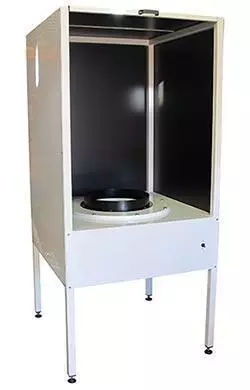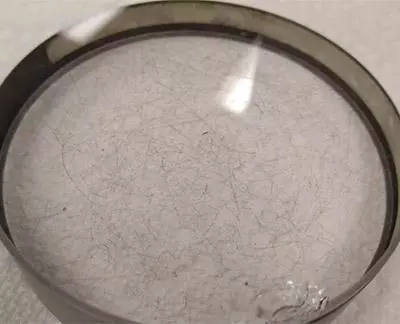Optical Flat - Single & Double Sided
Optical flats are used to check the flatness of a substrate. When a high quality optical flat is placed on top of a polished substrate and used with a monochromatic light source, light bands are formed. The number of rings or straight lines shown is an indication of how flat the part is.
Produced from Quartz, Kemet Optical Flats are available in single and double sided, 1/4 light band accuracy (Higher accuracy available on request), in sizes from 25mm up to 600mm diameter. Larger sizes made to order with configurations such as square optical flats, rectangle optical flats, donut optical flats and custom optical flat thickness are available. They are supplied with Certificate of Conformity with full traceability to international standards. Special optical flats are available on request.

Optical Flat showing light bands on substrate.

It is important to regularly calibrate optical flats and Kemet offers a calibration service to lambda/20 using 4" and 12" interferometers to measure the flatness of the optical flat and provide interferograms and inspection certificates.
Optical Flat Cleaning/Care Kit
It is also important to maintain optical flats using Kemet’s Optical Flat Cleaning/Care Kit, as taking special care of them will ensure accuracy and long service.

Large Optical Flats
| 1/4 light band. Lambda/8 | |||
|---|---|---|---|
| Diameter | Single Sided | Double Sided | |
| mm | Inches | ||
| 330 | 13 | ||
| 350 | 14 | ||
| 400 | 16 | ||
| 450 | 18 | ||
| 500 | 20 | ||
| 1 light band. Lambda/2 | |||
|---|---|---|---|
| Diameter | Single Sided | Double Sided | |
| mm | Inches | ||
| 600 | 24 | ||
Optical Flat Stands
Optical Flat Stands are required for the above Optical Flats for protection of optical flat and substrate being tested. Bench top optical flat stands for sizes 150 - 350mm and floor standing optical flat stands for sizes 350 - 600mm.

| Size (mm) | 1/4 light band optical flats (Lambda/8) | 1/10 light band optical flats (Lambda/20) | |||
|---|---|---|---|---|---|
| Diameter | Thickness | Single sided | Double sided | Single sided | Double sided |
| 25 | 10 | 361220 | 361237 | 361221 | 361238 |
| 50 | 10 | 361222 | 361215 | 361223 | 361239 |
| 75 | 15 | 361224 | 361705 | 361225 | 361240 |
| 100 | 17 | 361226 | 361210 | 361227 | 361241 |
| 125 | 20 | 361228 | 361242 | 361229 | 361214 |
| 150 | 25 | 361123 | 361216 | 361231 | 361243 |
| 200 | 30 | 361232 | 361219 | 361233 | 361244 |
| 250 | 35 | 361234 | 361217 | 361235 | 361245 |
| 300 | 40 | 361218 | 361246 | 361236 | 361247 |
Optical Flat Refurbishing
Over a period of time an optical flat can get scratched and/or chipped so it cannot be used or recalibrated without refurbishing. For small optical flats (less than 4”/100mm), depending on the level of damage, it may be more cost effective to purchase a new one but for larger flats Kemet offers a reconditioning/refurbishing/calibration service to lambda/20, with the use of interferometers and continuous pitch polishers. As with the calibration service interferograms and inspection certificates are provided for reworked optical flats.
The following shows some examples of optical flats that have been returned to Kemet for calibration (lightly scratched), re-polishing and calibration (more heavily scratched) and complete refurbishing (heavily scratched and/or chipped - chips are ground out and polished). Contact Kemet for a quotation.



Using Optical Flats with Monolights
The surface being examined must be smooth and reflective so that light will be reflected back through the optical flat.
On very hard materials, such as hardened alloy steel, the lapped finish will generally reflect sufficient light to give accurate readings. On soft materials, such as brass, copper, mild steel etc., it is necessary to polish the surface by rubbing the part on a polishing medium.
The operator, while using a figure of eight motion similar to that used in hand lapping, should hold the part in such a way that no distortion occurs to the polished surface. Most parts will polish more efficiently if thoroughly cleaned of all lapping vehicle and abrasive.
Optical Flat Adjustment
After the part has been polished to achieve reflectivity, it is placed under the monochromatic light source. Both the optical flat and the part must be clean and dry. If necessary, clean with a lintless material such as lens tissue or camels hair brush.
The optical flat should be placed or removed directly from the surface to be checked. Never slide the flat across the part surface as this will scratch the flat and shorten its useful life.
The width of the light bands is dependant upon the thickness of the air wedge which always exists between two parts. Minute particles of dust or dirt on either surface will hold the flat far enough away from the part so that the light bands will be very narrow and close together. The thickness of the air wedge can be decreased either by more cleaning or by gently pressing on the optical flat to force out some of the air. As the air wedge thickness decreases the light bands become wider. The width of the light bands or the number of bands does not affect the surface measurement, only the ease of making an accurate reading. The bands need only to be as wide as necessary for an accurate interpretation of their curvature.
